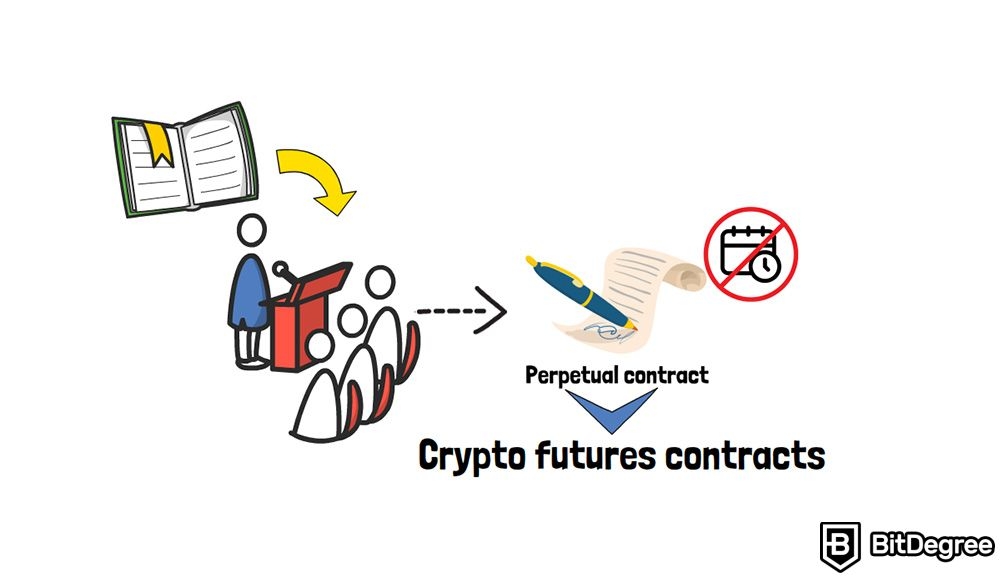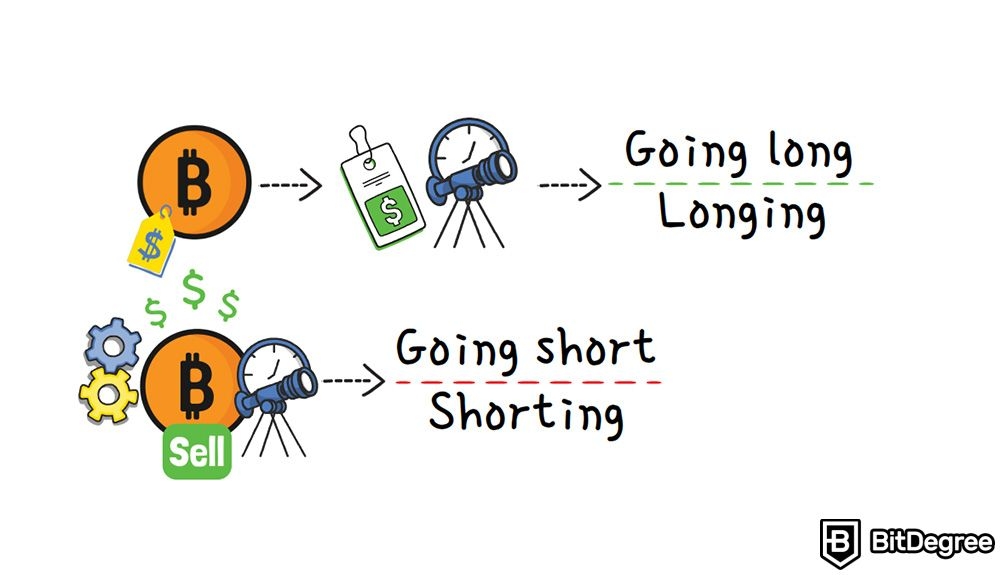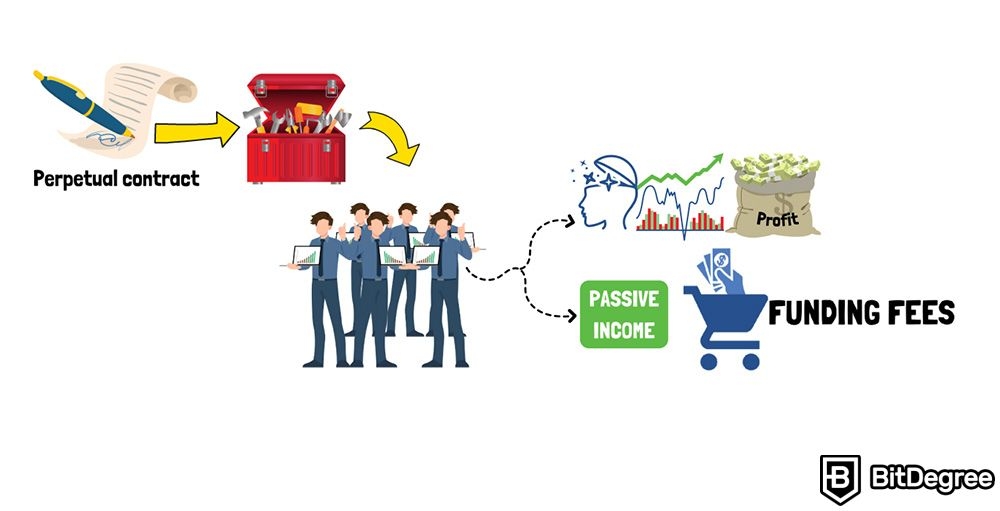7.7 Perpetual Contracts: Futures Contracts Without an Expiration Date
Free Airdrop Season 7 is LIVE! Answer fun questions or do simple tasks to earn rewards from the $30K BitDegree prize pool. Participate Now ! 🔥
In this section, I’m going to explain what is a perpetual contract in crypto!
Cryptocurrency trading is increasingly becoming a more and more popular activity. It makes sense, then, that there are new tools and services popping up, aimed at advancing this activity even further, as well as offering traders a variety of choices.
While perpetual contracts in crypto aren’t anything new, per se, they are definitely still a mystery to many. These trading tools are usually considered to be really advanced, and targeted at only the most experienced of traders. This, in turn, makes them out to be shrouded in mystery. Well, today, I’ll uncover this mystery, and tell you all about what is perpetual contract trading!
In this section, we’ll talk about perpetual contracts. To be a bit more specific, I’ll tell you about what these contracts are, how do they work, what type of traders they are going to suit best, as well as look into BYDFi - a specific exchange platform that specializes in perpetual contracts.
Let’s get right into it!
What are Perpetual Contracts, and How Do They Work?
As per usual, we’ll start off by getting the dry definitions out of the way, first. However, I do have to give a disclaimer here - while our goal is to demystify perpetual futures contracts, this topic still requires that you have at least a fundamental understanding of how the crypto market works, and what is cryptocurrency trading, in general.
If you feel like your knowledge could use a refresher, don’t sweat - there are dedicated sections in this Crypto 101 Handbook that cover these topics! Make sure to check them out, before diving into this section - it’ll make things much easier!
Alright, with that out of the way, let’s tackle the big question - what is a perpetual contract in crypto?

Well, as far as the definition is concerned, most reputable resources will tell you that perpetual contracts are “crypto futures contracts that don’t have an expiry date”. That doesn’t really help, now does it?
Let’s break it down.
Often referred to simply as “crypto perps”, perpetual contracts are, first and foremost, derivatives. As the term might suggest, a derivative is something that derives its value from an underlying asset - in this case, a cryptocurrency. So, in short, when you deal with perpetual contracts, you don’t actually buy or sell crypto assets - instead, you’re dealing with contracts that have their values tied to those cryptos.
That’s one part of what constitutes perpetual contracts in crypto. Another huge point that you need to consider is that perpetual contracts are a special type of “futures” contract. Once again, the term itself is a giveaway - futures contracts employ two parties (a buyer and a seller) to exchange a crypto asset of their choice sometime in the future, for a predetermined price.
The thing that makes perpetual futures contracts interesting, and different from simple futures contracts, is the fact that, with crypto perps, the trading usually (but not necessarily!) happens close to the underlying price of an asset, and you can actually hold your position indefinitely - in other words, it doesn’t expire.

Now, that’s a lot of seemingly-fancy terms that I’ve just thrown at you. Let’s put it all into place - here’s a down-to-earth example.
Imagine that, right now, Bitcoin costs $10,000. Judging by all of the different news stories coming out within the market, you sense that people are getting more and more bullish, and that the price might start rising really soon.
Since you’re a clever trader, you decide to jump on this opportunity, and utilize perpetual futures contracts to potentially make some profits.
So, you navigate to a reliable crypto exchange that has perpetual contract functionality (such as BYDFi), and set up your order. Since you believe that the price of BTC will rise to at least $15,000 in the next month, your order would sound a little something like this:
“Buy 1 BTC for $10,000 in one month”.
Of course, you don’t need to buy an entire Bitcoin, or any other cryptocurrency - this is just to keep the example as straightforward as possible.
So, in a month’s time, if BTC reaches $15,000, you’ll be able to acquire it for $10,000, which will give you a profit of $5000. As you’re learning about what is a perpetual contract in crypto, you will soon stumble across another really cool feature of perps - the fact that you don’t actually need to wait for an entire month to close your position.
So, for example, if you see that, during the month, the price of Bitcoin keeps on fluctuating, and you’re less positive that it’ll actually reach $15,000 at your specified point in time, you could close your position whenever you deem fit, whether it be in a week, 15 days, or else. There’s a lot of flexibility involved, which is definitely much appreciated!

Buying an asset at a specified price in the future is called “going long”, or “longing”, while the process of selling it is called “going short”, or “shorting”. These are terms that you’re likely to come across quite often, in your journey to figuring out what is a perpetual contract, so it’s a good idea to keep them in mind!
Another term that you also need to be aware of is “inverse perpetual contracts”. Once again, it sounds fancy, but it’s actually really simple.
Perpetual futures contracts are usually settled in USDT, or some other stablecoin. Inverse perpetual contracts, on the other hand, get settled in the underlying cryptocurrency. Not only that, but risk exposure, as well as margin, will also be calculated via the select cryptocurrency, instead of a stablecoin.
Yet another new term - margin! Bear with me - I know that I’m barraging you with complex crypto trading jargon, but all of these terms are really important to know, in order to fully understand what is a perpetual contract in crypto!

In margin trading, you would borrow funds from the exchange platform that you’re using, in order to trade with them. This is called leverage - the term “margin” essentially refers to the amount of money you would need to put up, as collateral for the borrowed funds.
So here’s an example.
Imagine that you found an apple shop, that sells large bags of apples for $100 each. You believe that the price of apples is going to go up, and that now’s a great time to buy them. However, you only have $20 in your pocket. So, you decide to borrow some money from a friend, at 100:1 leverage.
In a scenario like this, the margin could be as low as 1% of the price - so, $1! The rest of your money - $19 - can theoretically be used to buy anything else, even though it’s usually advisable to keep some money with you, in case the price of apples starts falling down, and your purchase starts working against you, so to speak. In a scenario like this, you would be forced to sell your apples at a loss, and would also have to give back the money to the friend that you borrowed it from.
What it all boils down to is this - with crypto perpetual futures, or even inverse perpetual contracts, you can participate in leveraged trades, thus boosting your potential financial gains (as well as losses, mind you!). Leverage is a risky tool to use, and is often preferred by experienced and advanced-level traders who know what they’re doing.
Introducing BYDFi - 200x Leverage in Perpetual Contracts
So, to answer the question of what is a perpetual futures contract, in short, it’s a tool used by (mostly) experienced traders who either want to speculate on how the market will turn, and potentially make a significant profit in doing so, or as a means of passive income, via something called funding fees.
Now, don’t worry - I won’t overburden you with even more complex terminology, since we’d be getting into some of the more advanced technicalities of crypto perps.
For the time being, though, we still need to talk about how to get started with perpetual contracts in crypto, if that’s something that you’d be interested in doing. While you could use any high-end exchange that you prefer, in this section, I’m going to be using BYDFi - a platform that Forbes considers to be one of the best cryptocurrency exchanges of the year!
BYDFi has a variety of different benefits to offer to its clients - everything from top-tier security and regulation, all the way to different trading tools, more than 400 different crypto assets, and appropriate trading fees. The reason why I chose this particular platform, though, is because perpetual futures contracts are actually one of its main features!

So, let’s get started, shall we?
First of all, you’ll need to navigate to BYDFi’s official website. Click the big yellow “GET STARTED” button at the top of the page. Here, you’ll need to enter all of your relevant details, such as your email, and think of a password. You can also register via a mobile number, as well.
Once you verify your email address, you’ll be registered - quick and simple!
Now, the very first thing that you’ll want to do is deposit some assets into your account. You could either transfer cryptocurrency that you already own, or purchase some, straight on BYDFi itself. If you choose to deposit, all that you need to do is navigate to the “Assets” section at the top of the page, click on “Deposit”, and pick a cryptocurrency and the correct network. An address will generate, and all you have to do now is simply transfer crypto to it - that’s it!
If you opt to buy cryptocurrency on BYDFi directly, the process is super-quick, as well. Simply navigate to the “Buy Crypto” tab under your “Assets” section, and you’ll be presented with a few different payment gateways. Enter the type and amount of crypto that you'd like to purchase, pick the currency that you want to spend, and choose the best gateways for yourself - after you complete your purchase, your BYDFi account will be credited!
Now that you have your funds ready, and have figured out what is a perpetual contract in crypto, you can go ahead and explore this part of BYDFi!
First, you’ll need to transfer funds from your Spot account to the perpetual contracts one. Then, you’ll need to, once again, navigate to the top of the screen, and hover over the “Derivatives” section. Here, you will see “USDT-M” and “COIN-M”. USDT-M are traditional perps, while COIN-M are inverse perpetual contracts. For the sake of this section, though, let’s take a look at USDT-M.
So, the first thing that you’ll want to do is check out the trading rules - you can find them by clicking on the little book below the “Assets” section, at the top of the screen. Once you’re familiar with the core rules of how crypto perpetual futures work with BYDFi, you can start exploring the interface, and trading.
Don’t forget to pick between isolated and cross-margin! What this essentially means is that, with cross-margin, you’ll be able to use funds from your available perpetual account balance, while isolated margin will essentially “dedicate”, so to speak, a set amount of money specifically for the open position.
BYDFi offers clients a lot of different customization options, as well as trade types. You can choose your type (Market, Limit, Stop Market or Stop Limit), your Take Profit / Stop Loss metrics, as well as your leverage. All of these actions can be performed from the menu on the right side of the trading interface.
So, all that’s left to do is set your preferred parameters, and start trading!
Wrapping Up
That’s about it! If you’ve read this section attentively, you should now be quite familiar with both what is a perpetual contract in crypto, as well as how you can start perpetual contract trading yourself, with the help of one of the leading crypto exchanges on the market - BYDFi!
Of course, granted that it’s such as vast topic, there were quite a few things that we haven’t touched on, such as the question of are perpetual contracts enforceable, the aforementioned funding fees, and many more. Either way, you now have a solid foundation for expanding your knowledge on perpetual contract trading further.









